vgthought.com
Platformer of the Month 1: Plok
Posted: 2014-04-07 23:33:42
Last edited: 2014-04-07 22:53:57
Last edited: 2014-04-07 22:53:57
This was originally posted on May 18, 2011.
This essay is the simplest introduction to platformer--and, well, art--structure I could make. It lacks specific commentary, but I think it works well as a getting-your-feet-wet-reading-structures kind of thing. It's the idea of breaking a stage into segments which are dominated by one idea, then viewing the stage as a sequence of those ideas.
Plok features both linear and maze stages, which could make for a nice introduction to a variety of stage structures. To keep things simple, though, I limited my commentary to the simplest stage structure in the game. Besides, it gave me room to talk about world structure, and the posts on Socket and Bonk's Adventure more than make up for what's missing here.
This essay is the simplest introduction to platformer--and, well, art--structure I could make. It lacks specific commentary, but I think it works well as a getting-your-feet-wet-reading-structures kind of thing. It's the idea of breaking a stage into segments which are dominated by one idea, then viewing the stage as a sequence of those ideas.
Plok features both linear and maze stages, which could make for a nice introduction to a variety of stage structures. To keep things simple, though, I limited my commentary to the simplest stage structure in the game. Besides, it gave me room to talk about world structure, and the posts on Socket and Bonk's Adventure more than make up for what's missing here.
Games discussed:
Plok
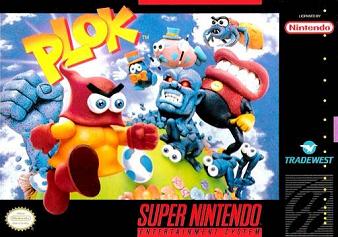
Plok
For those of you not in the know, Plok is about a guy who goes around throwing his limbs at things to kill them. Like many other platformers of the era, Plok features a set of independent levels to be completed in sequence, a sequence only to be changed if the player accesses a warp. Most levels are straightforward, asking Plok only to reach the end of a course; however, the game also features quite a few stages with fleas. These levels are mind-meltingly long, due in no small part to the fact that Plok cannot move on until he kills every single flea in the stage.
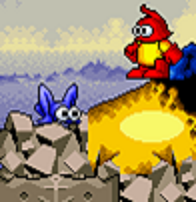
On the right, Plok; on the left, a flea with a very limited future.
Ask anyone about Plok, and they'll tell you two things: the gameplay is wonderful, and the game severely needs a save feature of some sort. Even the Pickford Bros. (the developers) acknowledge the latter one, calling Plok's lack of a password feature one of "only a few flaws in the implementation." Then again, I'm more a fan of reader response than authorial intent. Besides, Ste Pickford also insinuates that Plok is a cutesy platformer, when it is anything but.
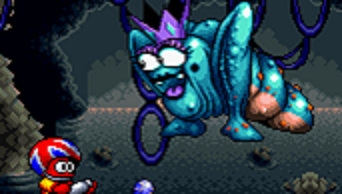
Friggin creepy. Wait, how do you pronounce "Ste"...?
Anyway, Plok makes a good pick for the first game of the month because the structure in Plok is both easy to identify and interesting.
Plok's structure is easy to identify because it plays fairly conservatively with its elements. For instance, among the first eight stages, there are 5 unique enemies, one of them being rolling logs. From there, the game introduces new enemies at a slow pace. Because new elements are introduced at a ginger pace, it's easy to observe the different ways they're put together.
However, that doesn't mean things get boring. Plok is very much interested in doing wild things with its structure.
Plok features a verse-chorus structure common to platformers, something I've discussed before. In short, this means that Plok establishes a main idea, then revisits it multiple times, with pauses for related ideas between.
To show you what I mean, here's a short synopsis of one stage from Plok.
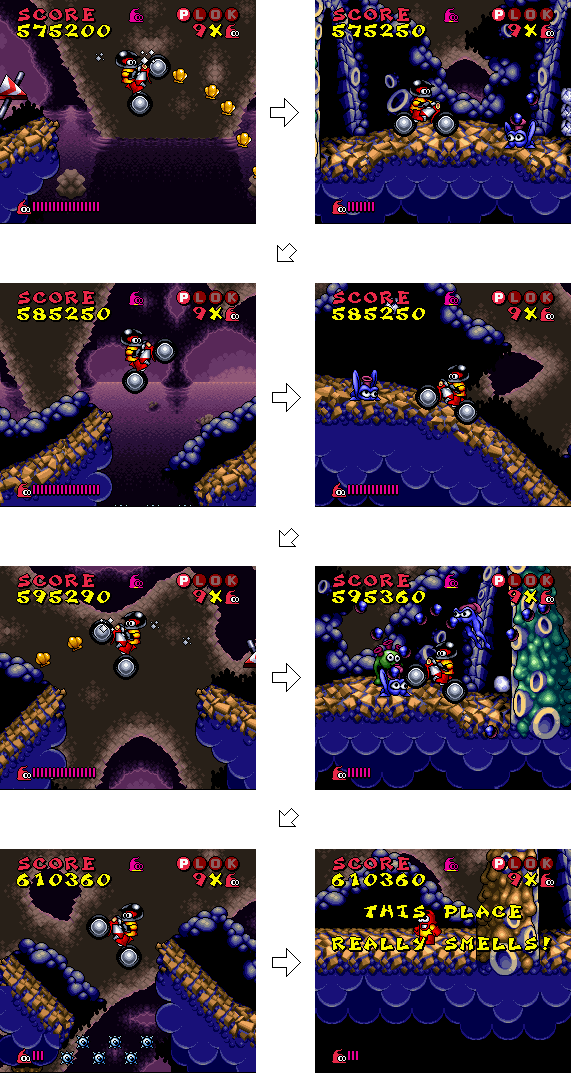
The gist of Easy Riding, one of the final stages.
On the left are pictured segments where Plok must cross gaps on his bike. On the right are pictured segments where Plok must defeat enemies. The final picture is the end of the stage and has nothing to do with combat. Easy Riding goes like this: cross some gaps, fight some enemies, cross some gaps, fight some enemies, cross some gaps, fight some enemies, cross some gaps, the end. That may seem like an oversimplification, but it isn't; there are no gaps in areas where enemies run amuck, and there are no enemies in places fraught with gaps.
It should be noted that this is one of the simplest stage structures in the game. In fact, the final 8 stages of Plok take an interesting, if odd, turn and go with very simplistic stage structures.
In this case, Easy Riding's main idea is in crossing gaps with the motorcycle. These sections are supplemented by portions of combat with the motorcycle. These two sections are related by the motorcycle; this is the only time Plok rides a motorcycle for the entire length of a stage. The stage, then, is a simple exploration of what it's like to play with the motorcycle. The stage covers both crossing gaps and killing enemies, placing its focus on crossing gaps.
But someone who's played Easy Riding might have trouble with that last statement.
There are more gap sections than combat sections, sure; and the stage does open and close with gap sections. However, the focus is definitely on the combat segments.
You see, Plok takes quite a lot of damage from hits, so it's important to be careful around enemies. In addition, the motorcycle's movements are slippery. This isn't a problem when speeding forward over gaps when Plok never needs to turn around, but it makes moving around enemies nigh impossible.
But that's not all. Enemies have a lengthy invincibility period after being hit. In fact, it seems to be longer than Plok's invincibility period. And every enemy in this stage will take three hits to go down.
Put these two elements together, and you'll be spending most of your time in Easy Riding fighting off enemies.
This is what makes Plok's structure interesting. The focus of it isn't immediately clear.
The largest example of this is in the game's flea killing levels. These are the most memorable levels in the game. While not entirely unique to Plok, they are less common than the standard “get to the end of the course” stages. These stages are also incredibly long, meaning that the bulk of the player's time with Plok will be spent playing these levels. Or, at least, it feels that way.
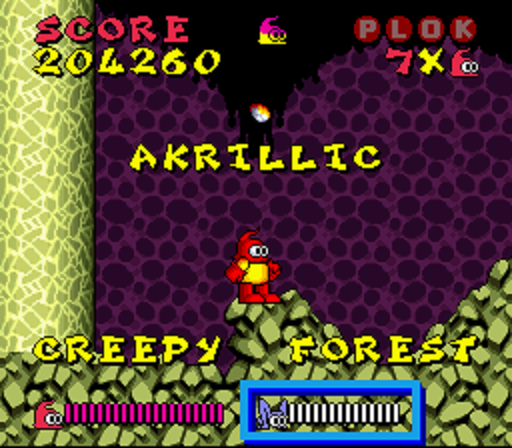
See that part boxed in blue? Each white notch represents one flea for you to track down and kill. Luckily, they aren't hard at all to find, and the game will tell you where the next one is.
And yet, the straightforward levels outnumber the flea killing levels two to one. Plok opens with straightforward stages and ends with straightforward stages. On top of that, the middle of the game—composed of flea stages—is interrupted by a string of straightforward stages. By all means, if the flea levels were of a normal length, they would be considered a sideshow in Plok: a nice diversion from the straightforward stages. As it is, they sit front and center.
To give a clear idea of Plok's overall structure, here's the sequence of stages:
Cotton Island
8 normal stages
1 boss
Akrillic Island
2 flea stages
Legacy Island
7 normal stages
1 boss
Akrillic Island continued
1 flea stage
1 boss
3 flea stages
1 boss
3 flea stages
1 boss
The Fleapit
7 normal stages
1 boss
Approached like this, there are six major stage sequences. There are three sequences of eight or seven normal stages followed by a boss; these would be Cotton Island, Legacy Island, and the Fleapit. Akrillic Island accounts for the rest: three sequences of three flea stages followed by a boss.
So things start to make sense. And, when you think about it, three flea stages are roughly the same size as seven normal stages.
Still, it's weird decisions like these that keep Plok interesting. Why is the first sequence of flea stages interrupted by a sequence of normal stages (Legacy Island)? Why does the final world focus so intensely on vehicles which have rarely been witnessed by the player up to that point in the game? Why introduce the player to a game full of standard, straightforward levels, then shift focus dramatically to the flea killing levels?
It should be noted that when I ask "why" here, I really mean to ask, "what impact does this have on the player?"
The stages themselves offer structures which are just as interesting. I only chose to feature Easy Riding here because it's easy to sum up quickly and clearly.
comments powered by Disqus
All original content on VG Thought was written by Greg Livingston AKA Golem.